She feels really easy and comfortable to sail, even in a good breeze and a chop.

Her owner describes this 18.5m cat as a ‘fun’ boat. That she undoubtedly is, but she also represents the pinnacle of New Zealand’s marine engineering and boatbuilding expertise.
You wouldn’t know it from a casual appraisal, but Cation is entirely carbon fibre. She weighs around 12 tonnes lightship and though she’s billed as a performance-cruiser the visual clues suggest the scale’s tipped to performance.
Consider the streamlined coachroof, the sleek, carbon-fibre rig, the black 3DI sails and square-top main, the knife-like hulls with their reverse bows, the asymmetric dagger-boards – and on it goes.
And for those who remember their high-school chemistry, a final clue is in the name and logo. A ‘cation’ (pronounced cat-ion) is a positively-charged atom – a phrase that perfectly captures the character of owner Graham Catley.
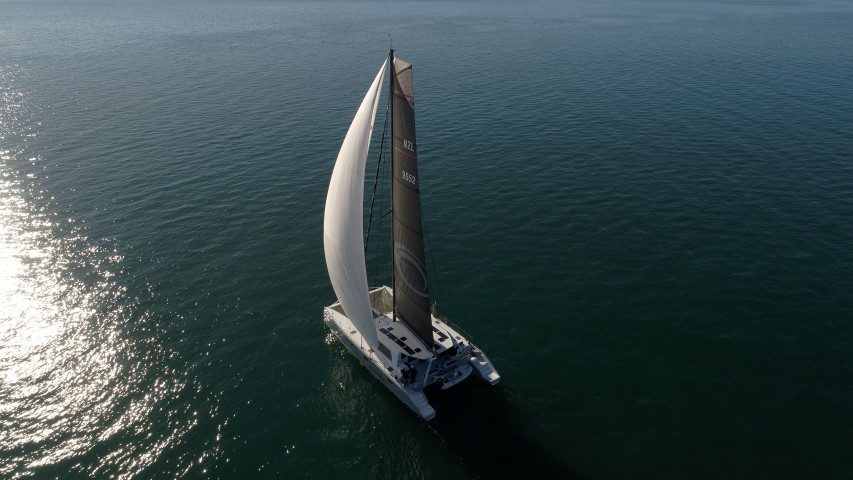
It also draws on his surname and, of course, the catamaran. A sailor with a long (and ongoing) background in the adrenalin-laced world of 18-foot skiff racing, it’s unsurprising his design brief called for a ‘go-fast’ yacht.
To designer Roger Hill’s credit, he’s smoothly blended the speed factor with easy-to-sail functionality and spacious, euro-style living. Covering all of Cation’s standout features is impossible within the confines of these pages, so given her bias I’ll home in on a few performance items that caught my eye.
The dagger-boards
For me, more than any other component, these encapsulate the depth of design, engineering and craftsmanship that’s gone into Cation.
Most performance-cruiser sailing cats are equipped with small ‘keel-lets’ to keep leeway in check. Those that do have dagger-boards usually have two-dimensional, straight up-and-down models – like centreboards. Cation’s are more like an AC50’s foils. The curve inboard, under the hulls and bridgedeck.
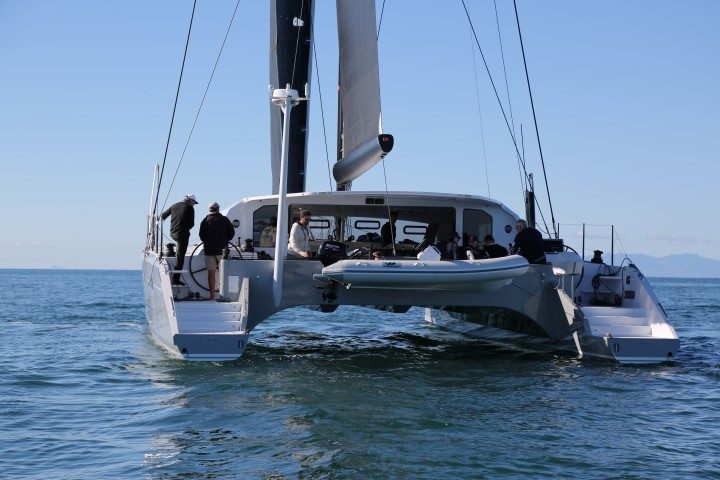
They also have an asymmetrical profile designed to add ‘lift’. When she’s doing 15 knots, says Hill, “the fully-deployed leeward board delivers around 4.5 tonnes of lift. This raises the pontoons a little, reducing wetted surface area and thus drag. It also contributes to Cation’s ability to point very high.”
Significantly, there is also a pragmatic slant to the boards’ design. The radius of the curve and ‘sheath’ is such that the boards can be removed from above for maintenance or repair. Curved boards usually have to be extracted from below, requiring a haul-out. Very clever.
Fully deployed, the dagger-boards give the cat a draught of 3.8m. Retracted, that’s reduced to 600mm. Similarly, the rudders are easily retracted – they’re equipped with an ingenious locking mechanism.
This means Cation can get into very shallow anchorages – an important part of the owner’s design brief. He wanted to be able to moor her really, really close to his bach. Just like the AC50s, Cation’s rudders have a horizontal T-section foil at the bottom.
Sail controls
Handling the sails on a spirited, 18.5m cat can be daunting at the best of times – let alone when short-handed. But Catley’s design brief called for easy handling as he and his wife plan to sail Cation alone for much of the time. I don’t know the lady, but I hope she has a ready supply of steroids on hand.
A couple of easy-control strategies will help: a self-tacking jib, a German mainsheet system allowing the sail to be controlled from either helm, and a very slick Ocean Furl boom-furling system from Hall Spars.
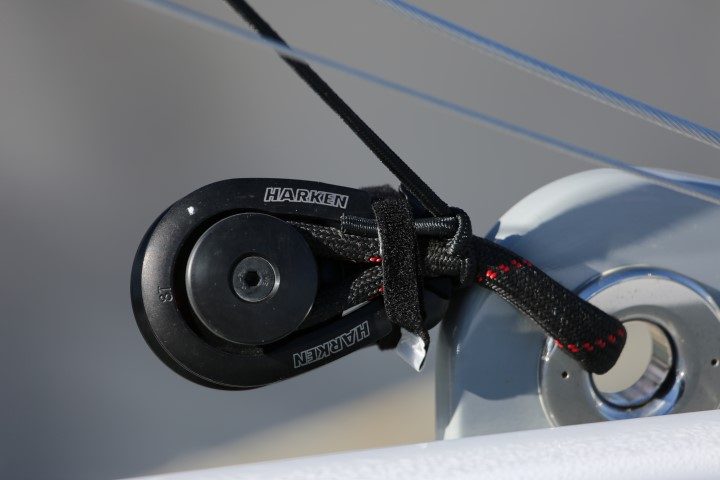
I was particularly impressed like the easy-to-use design of the main halyard – specifically, how it automatically engages/disengages at the head of the sail during hoisting/lowering. For anyone who’s laboured onto a boom to undo the halyard shackle on a deep-roach main, this auto system is a gem.
The boom-furling main and the ability to switch to the smaller staysail present quick, easy reefing options, even though reefing isn’t really wired into Catley’s DNA. He prefers to “play with the shape and camber of the main to keep her on the edge.” I’m sure he means the boat, not his wife.
A near full-width curved traveller along the back of the bridge deck and a powerful hydraulic kicker offer plenty of scope for adjusting the main’s shape. And because nearly all of Cation’s numerous Harken winches are electric, it’s easy to maintain your dignity while raising/adjusting sails.
I also like the design philosophy of the sail controls. Sheets and lines are cleverly concealed within the structure, reinforcing the cat’s clean lines and sleek cabin top. A good example is the single mainsheet at the end of the boom – it’s completely incongruous for handling the massive sail’s loads. But a little investigation reveals that the single line runs through a 4:1 purchase system hidden inside the boom. Minimal drag and very, very neat.
The rig
Hall Spars’ 25m mast carries an impressive spread of sail – a little over 200m2 between Cation’s main and jib. Her gennaker adds a further 276m2.
Some high-tech gear has been employed to keeping it all stable and aerodynamically efficient. The carbon forestay, for example, has a round, low-drag profile. The sail slides over it – very different, and much lighter, than a conventional aluminium section and track. Stays and shrouds are E6 carbon fibre and the rig’s diamond stays are aramid.
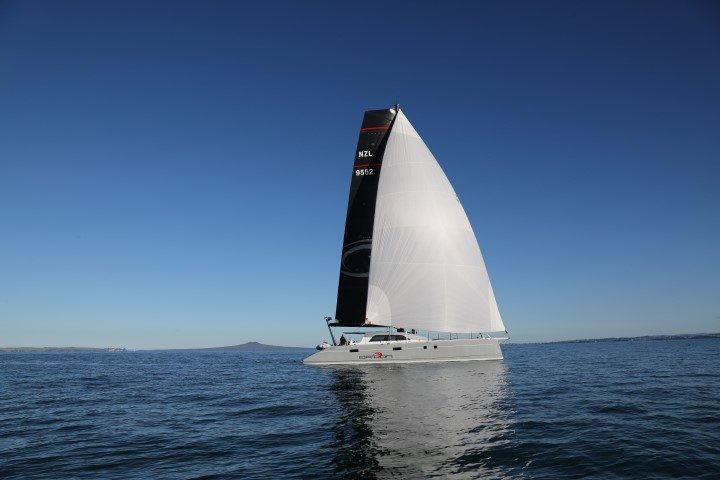
Accommodation
For all her performance-oriented features, Cation is a supremely spacious and comfortable vessel, designed to meet the needs of up to eight in stylish splendour.
Sleeping arrangements are divided between two identical master suites (port and starboard) just forward of midships, oriented east-west. Each has a large double bed and en suite bathroom with separate toilet and shower.
Two guest cabins – oriented north-south – are aft. The one in the port hull also has a large double bed. It shares its en suite bathroom with guests in the starboard cabin. This cabin has two singles which can be converted into a double with a fill-in. Depending on how well the guests know each other, the sleeping arrangements offer plenty of flexibility.
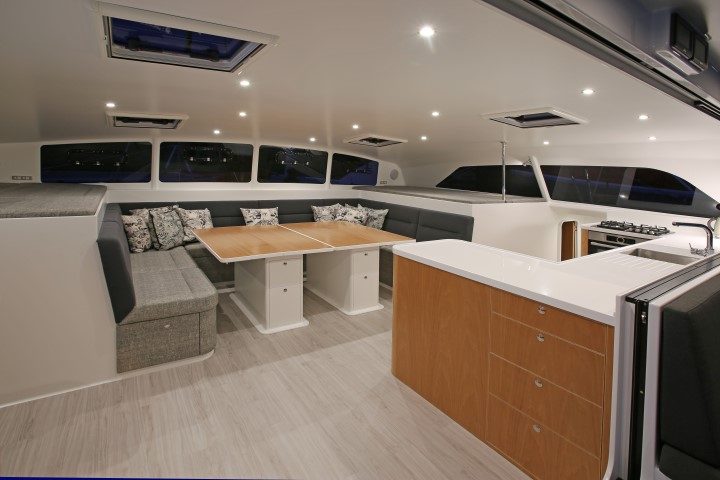
When dinner parties become well-oiled and guests can’t find their tenders, there are additional daybeds either side of the saloon. And speaking of dinner – I was impressed by the saloon table’s clever design. It folds/unfolds easily into various sizes to cater for the occasion. Fully-deployed, it will seat 10 – 12 people in comfort.
With her 9m beam, Cation offers truckloads of space – even for the chef. It’s very modern and functional galley with crisp, minimalistic décor. Essential accessories include a Fisher & Paykel dishwasher and three fridge/freezers.
There’s a large Fridgetech top-loading freezer built in to the cabinet below the navigation station, a conventional fridge in the galley, and a massive fridge built into the cockpit port locker – quick access to chilled wine for those enjoying al fresco dining at the spacious cockpit table.
I like the window/door arrangement separating the cockpit and saloon. Both are sliding models which disappear neatly into the bulkheads – and when everything’s tucked away, the ‘flow’ between saloon and cockpit is seamless. Glorious design.
Given her size and accommodation layout, configuring Cation’s electrical systems would have proved a daunting prospect with conventional wiring. Instead, she’s been fitted with a CZone system, technology which offers a much easier installation and the appropriate lighting/ambience at the touch of a button. And with a weight-conscious owner (the boat, not Catley) CZone also shaves significant kilos off displacement by minimising wiring.
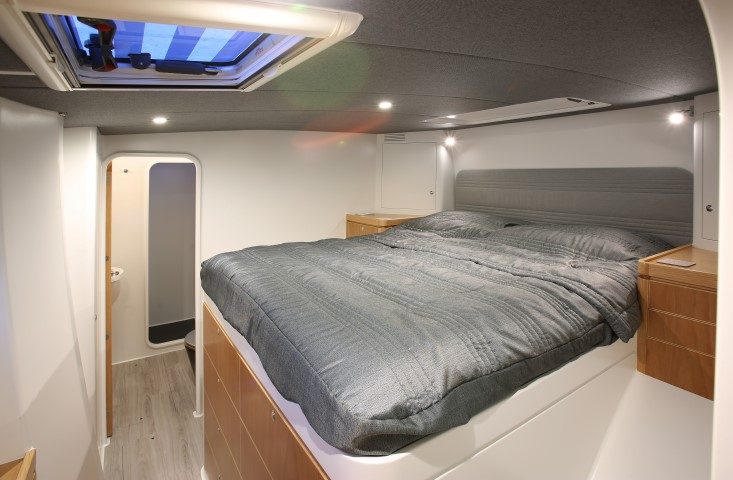
As with the running rigging which has been cleverly concealed, so Cation’s clean interior is accentuated by discreet design. Consider the flat-screen TV which lives in a concealed cabinet in the saloon and emerges/disappears at the touch of a button.
Most of the vessel’s accessories run off 240-volts AC. Most of the time it’s from the batteries via an inverter, but if necessary a 12kW Fischer Panda generator kicks in. It’s mounted in a forward locker, and Catley says it’s impossible to feel or hear it running.
When the sun’s out, the batteries are tickled into health but an array of solar panels on the cabin top. They are ultra-thin, flexible models and mould themselves perfectly to the contour of the substrate. If you didn’t know they were solar panels, you’d be forgiven for thinking they were part of Cation’s paint job.
Performance
I’m not naturally a cynical person, but after decades of boat reviews I’ve come to believe the weather gods are a spiteful bunch. When they learn Boating New Zealand is planning a boat review which involves cameras, they immediately conspire and send either rain with waaaaaaaay too much wind, or sunshine and no wind at all.
We had the latter with Cation. I was keen to experience her pedigree in 15 – 20 knots. The gods offered six – and very intermittently.
Still, even in the light airs, she offered an intriguing glimpse into her potential performance. We were able to sail a little faster than TWS – just over six knots in six knots of wind. Extrapolate that to 20 knots TWS and you have the making of an arrhythmic heart.

The twin 75hp Yanmars with folding props also offered a hint at her slipperiness. At 2,500rpm she cruised effortlessly at 10 knots. The engines’ fly-by-wire electronic controls are ultra-smooth and made piloting her into her Gulf Harbour berth entirely fuss-free.
Catley doesn’t like going anywhere slowly and wanted a fun boat that could get him to the tropics at a decent pace. I think he’s covered all the bases with her. But it doesn’t sound like he’ll remain in a cruising mindset for too long. He already has plans to enter the next Coastal Classic and participate in a few races across the Tasman.
I’ve no doubt these will be exhilarating – with the ions charging through the helmsman’s veins.
Sidebar – The engineering/build team
While Cation is a Roger Hill concept, she’s also the synthesis of high-tech engineering with input from many sources. “I designed her,” says Hill, “but everyone in the team provided specialist expertise, optimising weight and introducing modifications to make sure she’d meet her performance objectives.”
They include Westhaven’s Pure Engineering – responsible for the Finite Element Analysis and ensuring that the structure would cope with the considerable loads imparted by the rig.
Composite engineering guru Daryl Senn orchestrated the curing, while Bob Graham provided the mechanical engineering smarts. She was built by Jon Douglas.
Sidebar – The sails
Cation’s gleaming black sails are 3DI Endurance models from North Sails’ Auckland loft. “Most sails are a compromise between performance and longevity,” says North’s chief designer Burns Fellow. “I like to think 3DI sails offer the best of both worlds – they’re offer superior performance and hold their shape for much longer than conventional woven sails.”

The basic wardrobe features a fully-battened, square-topped main (boom-furling), a jib and a removable inner staysail. A 276m2 gennaker’s deployed for downwind sailing. There are also two code 0s – one unusual in that it’s designed for hotter, upwind angles. Fellow calls it a ‘code 0.5’.
Also unusual is the furling jib. It’s equipped with horizontal FlexiFurl battens manufactured by Auckland’s C-Tech – their ability to roll up neatly around the forestay remains a mystery to me.
She feels really easy and comfortable to sail, even in a good breeze and a chop.
At first glance the boat appears to be a large centre console, although hidden beneath the console and forward area is a sizeable overnight cabin.
With classic styling, good performance and class-leading ride and handling, there’s a lot to like about the Caribbean 32.
Solar panels on the vast roof help keep the batteries charged.